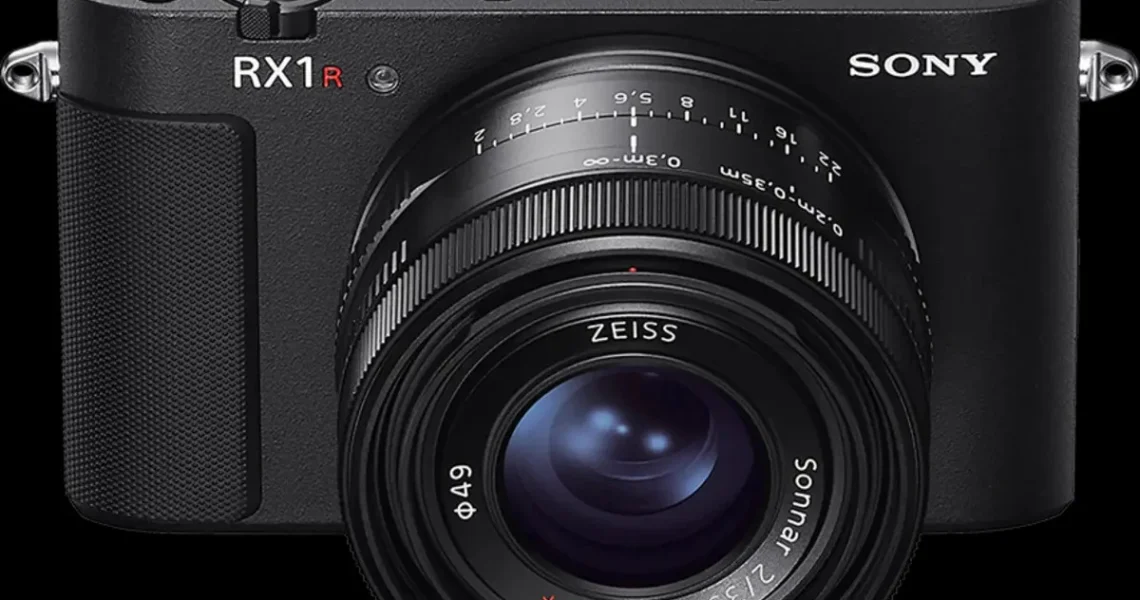Sony RX1R III: Pocket Powerhouse Camera
The heart of the Sony RX1R III’s imaging capability is its advanced sensor and meticulously chosen lens. The camera features a 61-megapixel (MP) Exmor R sensor, a state-of-the-art full-frame chip designed to capture an extraordinary amount of detail and light.
This high resolution offers photographers immense post-production flexibility, allowing for aggressive cropping while retaining exceptional image clarity and sharpness. Previously, the RX1R II featured a 42.4-megapixel sensor, making the 61MP leap a significant upgrade that enhances fine detail rendition and creative versatility.
Paired with this high-resolution sensor is the renowned Zeiss Sonnar T 35mm F2 lens*. This fixed prime lens is celebrated for its exceptional optical quality, delivering superb sharpness, contrast, and beautiful bokeh (background blur). The 35mm focal length is a versatile choice, often favored by street, documentary, and portrait photographers for its natural perspective that closely mimics human vision. Its wide F2 aperture allows for excellent low-light performance and shallow depth of field control, further enhancing creative expression.
To maximize the utility of this fixed lens, Sony has incorporated a clever feature called “Step Crop Shooting.” This innovative function allows users to instantly switch between 35 mm, 50 mm, and 70 mm focal lengths through intelligent sensor cropping. Instead of physically changing lenses, the camera digitally crops the high-resolution sensor to simulate the field of view of a longer lens. For example, selecting 50mm will crop the 61MP image down to a still highly usable resolution, providing a tighter composition directly in-camera.
This feature offers remarkable flexibility for a fixed-lens system, enabling photographers to adapt their framing on the fly without complex post-processing. Additionally, the RX1R III includes a macro mode, allowing photographers to get as close as 7.8 inches (20 cm) to subjects. This close-focusing capability expands the camera’s versatility, making it suitable for capturing intricate details of small objects, flora, or textures.
AI Integration and Advanced Autofocus: Intelligent Shooting
Modern camera technology is increasingly leveraging the power of artificial intelligence (AI), and the Sony RX1R III stands at the forefront of this evolution. The camera incorporates a dedicated AI chip on board, which is a central component for enhancing various aspects of its performance. This chip processes data rapidly, enabling more sophisticated and reliable camera functions.
One of the key benefits of this AI integration is enhanced image processing. The AI algorithms work to optimize image quality, intelligently adjusting parameters like noise reduction, color rendition, and dynamic range to produce stunning results straight out of the camera. This ensures that the high-resolution output from the 61MP sensor is not only detailed but also aesthetically pleasing.
Furthermore, the AI chip plays a crucial role in the camera’s subject detection capabilities. It can intelligently identify and differentiate between various subjects, such as humans, animals, and potentially even vehicles, allowing the camera to prioritize focus and tracking. This leads to significantly more accurate and reliable autofocus performance, particularly in dynamic shooting scenarios.
Complementing this, the RX1R III features real-time subject tracking, a highly advanced autofocus mode that locks onto a moving subject and follows it continuously across the frame. This ensures that even fast-moving subjects remain in sharp focus, making it ideal for capturing fleeting moments or action shots. The real-time tracking system is powered by the AI chip, which predicts subject movement based on various parameters, including color, pattern, and spatial information.
The autofocus system itself is robust, boasting 693 phase-detection autofocus points. These points cover a significant portion of the sensor area, providing wide and precise autofocus coverage. Phase-detection AF is known for its speed and accuracy, making it highly effective for capturing subjects in motion. This extensive AF coverage, combined with AI-powered subject detection and real-time tracking, ensures that the RX1R III can quickly and accurately achieve focus in a wide range of challenging situations.
Beyond its technical prowess, the RX1R III also embraces contemporary creative trends. As seen on many modern cameras, it features a selection of 12 stylized ‘Creative Looks’. These are essentially in-camera filters or color profiles that can be applied to both photos and video, allowing photographers and videographers to instantly impart a specific aesthetic to their work. These looks range from vibrant and punchy to muted and film-like, providing creative flexibility without requiring extensive post-processing.
In terms of shooting speed, this model tops out at five frames per second (fps), which, while not class-leading for action, is sufficient for many creative and portrait applications. For video enthusiasts, the camera offers versatile capture options, including 4K resolution at 30 fps, providing high-quality, detailed video footage. For those who prioritize slow-motion effects, it also supports 1080p (Full HD) video capture at up to 120 fps, allowing for smooth, dramatic slow-motion playback.
Ergonomics, Build, and Battery Life: Designed for Discretion
The Sony RX1R III’s design philosophy prioritizes compactness, premium feel, and discreet operation, fitting its role as a high-end, take-anywhere camera. The camera body is meticulously crafted from magnesium alloy, a lightweight yet incredibly durable material known for its strength-to-weight ratio. This choice of material contributes to the camera’s robust feel without adding unnecessary bulk.
In a notable design change from its predecessor, Sony has ditched the articulating back panel of the RX1R II for a fixed one. This decision was a deliberate effort to keep the overall weight down to a mere 1.1 lbs (498 grams). While an articulating screen offers flexibility for shooting from awkward angles, a fixed screen contributes to a more streamlined and potentially more durable design, appealing to purists who value a compact form factor above all.
Despite the fixed design, there’s now a vibrant fixed LCD touchscreen on the back. While a fixed screen might make for slightly more cumbersome composition when shooting from very low or high angles, the benefit is often a more robust display panel. Touchscreen functionality enhances usability, allowing for intuitive navigation of menus, tap-to-focus, and quick setting adjustments. For precise framing, especially in bright conditions or when a traditional shooting experience is preferred, the RX1R III also features a “high resolution and high contrast” OLED viewfinder. OLED technology provides deep blacks and vibrant colors, offering an incredibly clear and accurate representation of the scene, which is crucial for critical focusing and composition.
Powering this compact powerhouse is a much larger fast-charging battery than its predecessors. Battery life is a critical factor for any portable camera, and Sony has significantly improved it. When fully topped up, the new battery is capable of providing power for up to 300 still images. While this might not seem exceptionally high compared to larger mirrorless cameras, it represents a substantial improvement for such a compact full-frame device, providing enough juice for a decent day’s casual shooting without constant battery anxiety.
The “fast-charging” capability further enhances convenience, minimizing downtime between shoots. The combination of a lightweight magnesium alloy body, a high-quality fixed screen and OLED viewfinder, and improved battery life underscores Sony’s commitment to delivering a premium, highly portable, and user-friendly shooting experience.
The Price Point and Market Comparisons: A Luxury Contender
The Sony RX1R III, with its advanced features and compact, premium build, is unequivocally positioned as a luxury shooter for discerning photographers. This is immediately evident in its eye-watering asking price of US$5,099. This price tag places it firmly in the high-end segment of the camera market, catering to enthusiasts and professionals who prioritize portability, image quality, and a fixed-lens shooting experience above all else.
Adding to the overall cost, photographers might consider tacking on a range of optional accessories. Items such as a dedicated body case, a lens hood, and a thumb grip are typically sold separately, with each accessory adding a couple of hundred dollars to the total bill. These extras, while enhancing protection or ergonomics, further solidify the RX1R III’s status as a premium investment.
At this elevated price point, the RX1R III enters territory shared by some formidable and distinctly different photographic systems. For instance, for approximately the same investment, one could consider the Fujifilm GFX100RF. This is a “slightly different affair” entirely, as it features a medium format 102-megapixel sensor. While the GFX100RF is a much larger camera with interchangeable lenses, its medium format sensor offers unparalleled resolution and image quality, appealing to those who prioritize ultimate detail over pocketability. The comparison highlights that the RX1R III’s value proposition isn’t purely about resolution (though it’s high) but about its unique blend of full-frame quality in a genuinely compact body.
Perhaps a more directly comparable competitor, especially for its fixed-lens, full-frame luxury appeal, is Leica’s Q3. The Leica Q3 is “more closely comparable” due to its similar fixed-lens full-frame concept, and it’s currently listed at an even higher price point of $6,735. This comparison underscores that Sony’s pricing for the RX1R III, while high, is not entirely out of sync with other top-tier luxury fixed-lens cameras in the market, suggesting a dedicated segment of buyers willing to pay a premium for such specialized tools.
Interestingly, industry experts like the folks at PetaPixel have pointed out a compelling alternative from Sony’s own lineup: the compact a7CR. This camera is “a lot cheaper,” yet it features the same 61MP sensor and the same advanced focusing chops as the RX1R III. Its significant advantage lies in its interchangeable lens mount, allowing photographers to use a wide array of Sony E-mount lenses. For around $3,800, one could acquire the a7CR system bundled with a nice prime lens, such as the Sony 24mm F2.8 or 40mm F2.5, and still retain the immense flexibility to “build it out further” with additional lenses as needed.
This internal competition from Sony’s own a7CR highlights a crucial decision point for potential buyers. If you’re trying to choose between the RX1R III and the a7CR, it becomes imperative to have a good think about what your typical shoot days look like and the kind of flexibility you genuinely need while on location. The RX1R III champions ultimate portability and a streamlined, fixed-lens approach, forcing creative constraints that some photographers thrive on.
The a7CR, conversely, offers similar core image quality and autofocus performance with the unmatched versatility of interchangeable lenses. This choice ultimately comes down to a photographer’s specific workflow, preferences for compactness versus versatility, and their willingness to invest in a highly specialized, albeit technologically advanced, fixed-lens system. Pre-orders for the RX1R III are available on Sony’s official site, with shipping expected by the end of July.






